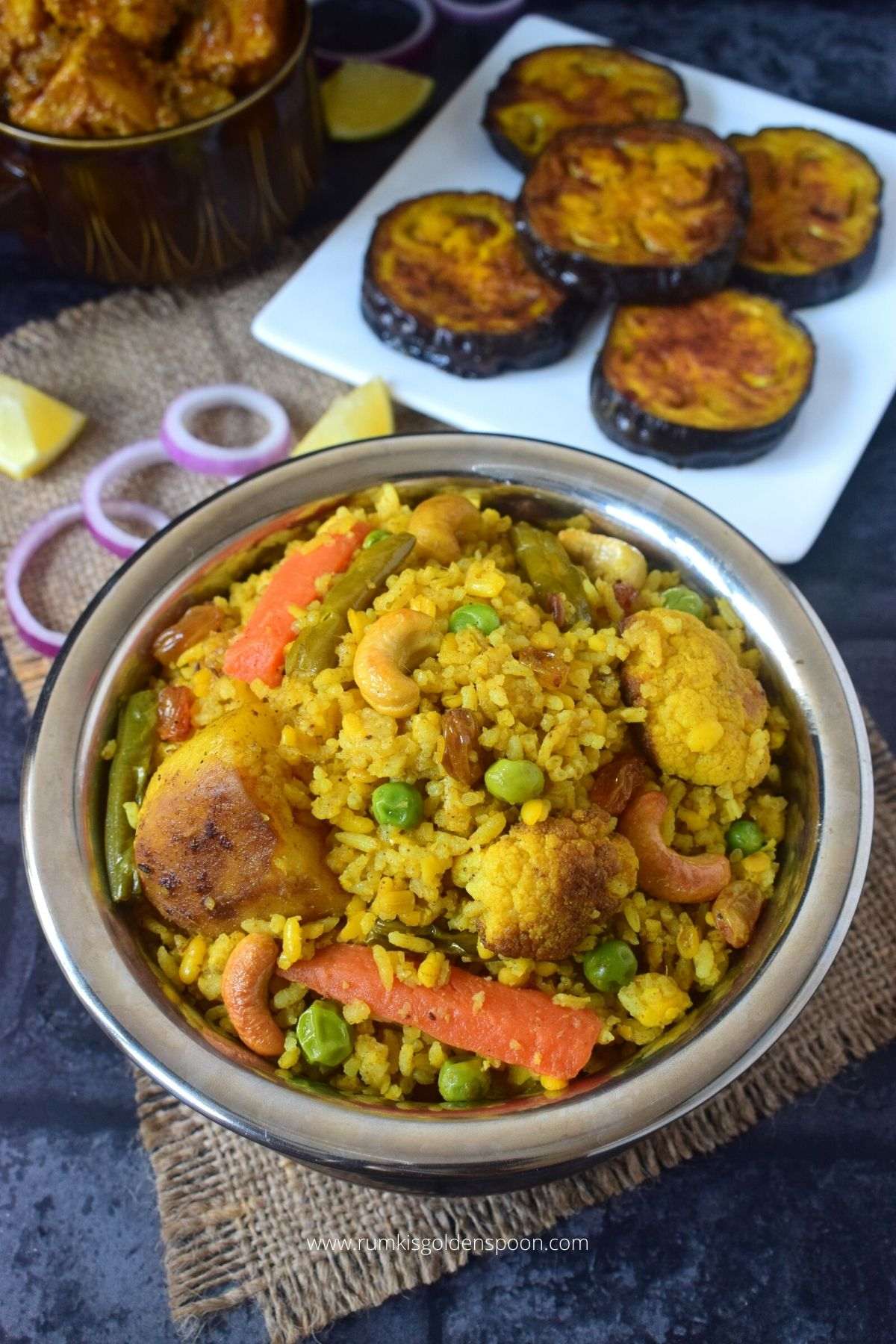Bhoger bhuni khichuri aka bengali bhuna khichuri recipe is an exemplary and unique niramish khichuri which is prepared in puja festivals like Durga Puja, Laxmi Puja, Saraswati puja etc. and is offered to the goddesses as Prasad. This splendid jhuro khichuri recipe is equally loved by the people of all age groups. The texture of bhuni khichuri is completely different from regular bhoger khichuri. It is dry and grainy in texture exactly like pulao with extraordinary taste and flavour. In this preparation, gobindobhog chaal (Small grain rice) and shona moong dal (Split yellow lentils) are fried together and then cooked in hot water with some veggies in a specific spice blend. It is mostly accompanied with bhoger labra, niramish aloor dom, begun bhaja and chatni.
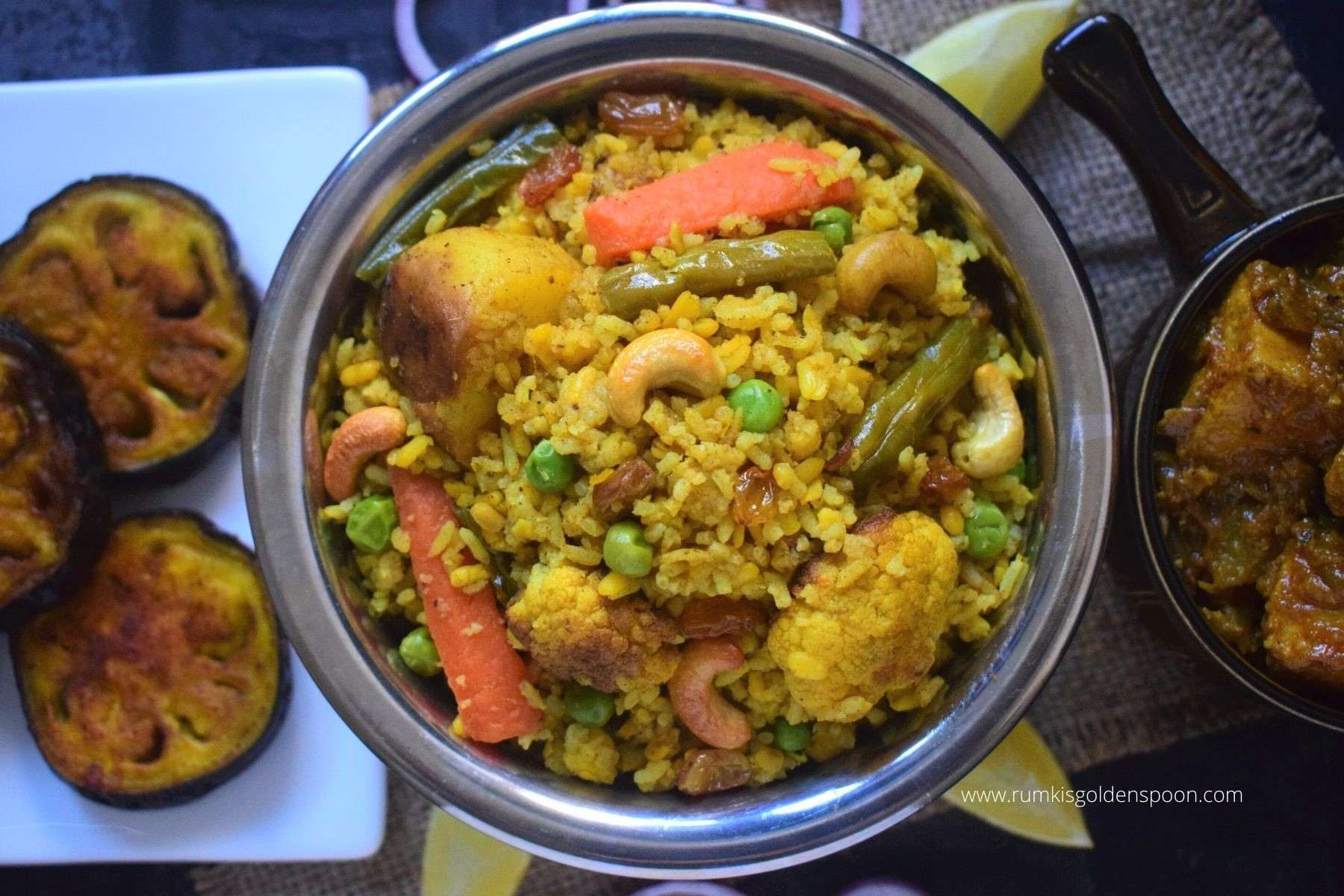
Table of Contents
About the recipe
Tips and Suggestions
How to make Bhuna Khichuri (step wise photos)
Recipe Card
About the recipe
Bhuni khichuri aka bengali bhuna khichuri recipe is a pure Bengali delicacy. Here both the words ‘Bhuna’ and ‘Bhuni’ means fried and ‘khichuri’ means a rice-lentil mishmash. For the dry and grainy texture like pulao, both rice and lentil are fried together thoroughly before cooking in water and hence its specifically called Bhuna khichuri or bhuni khichuri.
Bhuna khichuri recipe is prepared in myriad ways. Every house has their own composition and preferences in preparing any khichuri recipe. In many houses, bhuna khichuri is prepared with different types of lentils like masoor dal (red lentils) or chana dal (split chickpea) other than moong dal (yellow lentils).
In fact, bhuna khichuri can be prepared in both the ways, like vegetarian and non-vegetarian. Bhuna khichuri with mutton or chicken is an exclusive non-vegetarian khichuri recipe which is crazily popular among Bengalis, especially in Bangladesh.
In vegetarian category, it can be prepared in two different ways, one by using onion-garlic and another is a no onion no garlic recipe. The bhuna khichuri using onion-garlic is hugely popular in Bangladesh and frequently prepared during gloomy or rainy days. I have already shared the bhuna khichuri recipe using onion-garlic with you which you can check in my previous post.
Without onion garlic recipe for bhuni khichuri recipe aka niramish bhuna khichuri is mostly prepared in puja festivals like Durga Puja, Laxmi Puja, Saraswati puja etc. and is offered to the goddesses as Prasad. Today, I am going to share this exclusive bhuni khichuri recipe aka bhoger bhuni khichuri with you which is crazily popular in West Bengal during festive days.
For Bengalis, niramish recipes during puja or rituals mean complete veg where all the food is without onion garlic recipes. In fact, for Bengalis masoor dal (Red lentils) is also strictly prohibited during those niramish days. So, bhoger bhuna khichuri is always prepared with moong dal (Yellow split lentils). It’s a must to clean the kitchen and use separate utensils where only veg items are getting cooked before preparing bhoger prasad for offering to God.
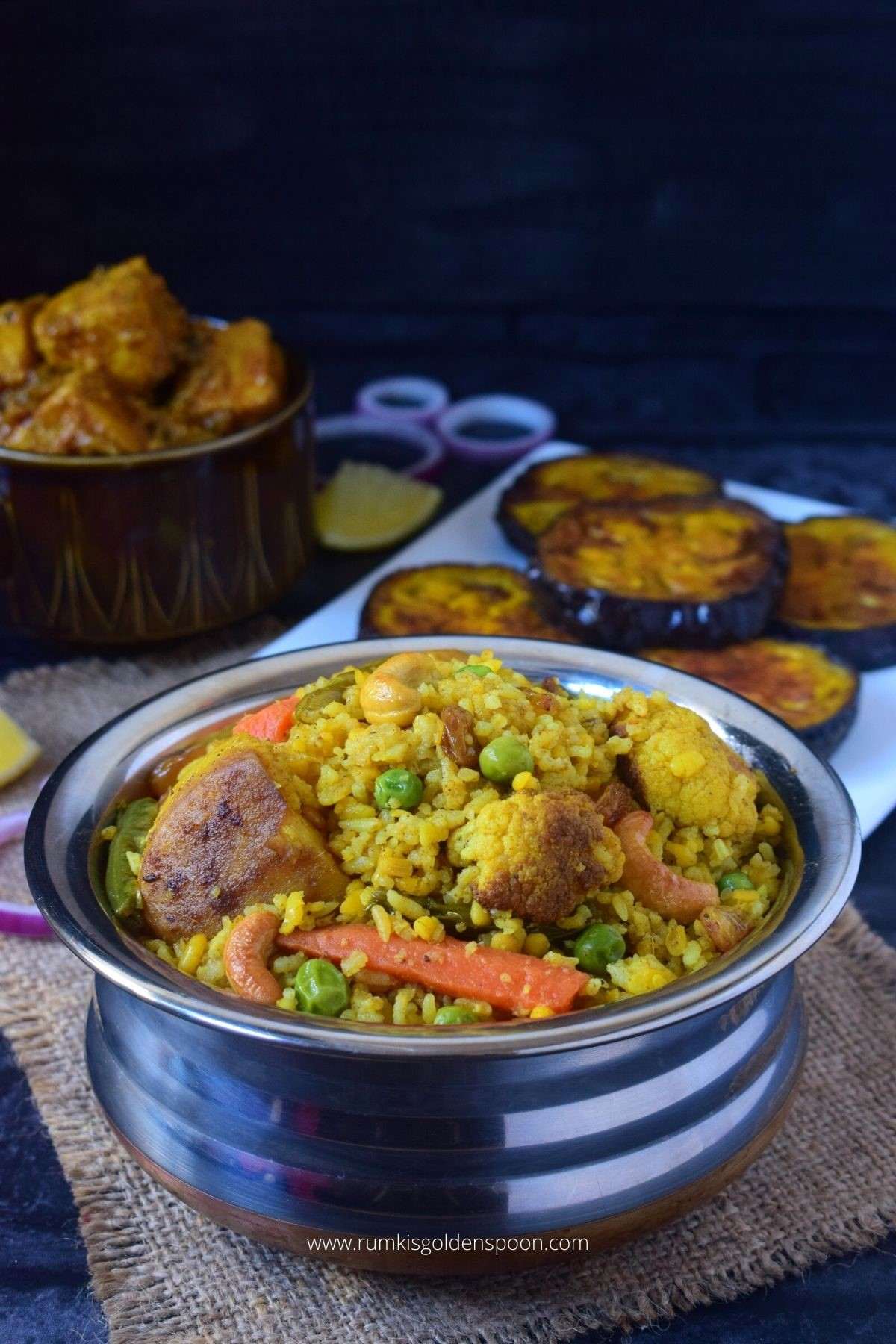
Bhoger khichuri is always much more than food for any Bengali people. For them, it is a way to connect to the God with pure heart. From ages, people have been preparing this anna bhog and the first offering to God as a part of naivedyam. It is then distributed to the people as prasad. Naivedyam is a Sanskrit word which means food offering to God. It is a holy part of the worship ritual.
Many people believe that the taste of bhoger khichuri whether its bhuna khichuri or regular one can’t be recreated at home or any other place except temples or puja mandaps because it is prepared for God and is offered to her first. And it is due to Gods’ blessings that the bhog tastes supreme. Many people also believe that the touch brahmins make it taste unique.
But according to me, as are we all completely devoted to God during those puja days, it makes us feel like that. You can prepare the same bhoger bhuna khichuri in your kitchen which will taste the same but anyhow that feeling will be missing on regular days. Bhoger prasad is not all about recipe. It is a part of our culture and festive celebration.
As a bong, I have grown up eating this divine and every time it totally engages me with its irresistible taste, unbeatable flavour and amazing texture. I have thousands of good memories with this traditional Bengali food and whenever I talk about it, I always feel nostalgic.
To prepare bengali bhuna khichuri recipe, you would need a little bit of arrangement and ample amount of time to cook the food. It is a pure Bengali delicacy and requires core Bengali ingredients, including the specific rice variety to get prepared. The best part of preparing the moong daler khichuri is that you can prepare it in huge quantities investing same amount of time and energy.
Honestly, bhuni khichuri is a tricky recipe and it should be prepared using proper techniques and measurements. If either of the one goes wrong, then the whole dish may collapse. The soggy Bengali bhuna khichuri recipe never tastes the same as a perfectly cooked dry and grainy one. So, I must say the difficulty level of preparing this dish is moderate.
I have kept the bhoger bhuna khichuri recipe as simple as possible so that you don’t need to face much difficulties during the time of cooking it. I have cooked the khichuri in a pan aka kadai like traditional way. Many people use shortcut to prepare the bhuni khichuri in pressure cooker. But I must say the pressure cooker cooked bhuni khichuri will not give you the same texture and taste. I personally prefer the traditional way to prepare it for best result.
Bhuni khichuri with step by step photos and instructions have been provided in the ‘Instructions’ section of the recipe. I have included all the tips and tricks to prepare perfect the Bengali bhuna khichuri recipe. If you follow the steps precisely then you will get perfectly cooked and non-sticky pilaf-like jhuro khichuri. But before directly jumping into the recipe, let me share few interesting facts about the Bengali veg recipe.
Tips to prepare perfect Bhuna Khichuri
- Always use Gobindobhog rice (an aromatic small grain rice) for the recipe. Don’t replace it with Basmati rice.
- Always take equal amount of rice and lentil for bhoger bhuni khichuri. I mean for 1 cup of rice, take 1 cup of lentil.
- Dry roast the moong dal separately for some time and then wash the dal. It gives better flavour to the khichuri. Don’t mix rice and dal together and wash them together before frying.
- Roasted moong dal always takes longer to get cooked than rice. So, soak the moong dal at least for half an hour in water before cooking.
- Don’t reduce the amount of oil and ghee or else the rice and lentil won’t get fried properly.
- Fry the rice and dal together thoroughly with the masala. The texture of the khichuri partially depends on this step. The more nicely you fry them, the khichuri will become perfect in texture.
- Always use fresh homemade masala or bata masala for the authentic flavour. It gives much better flavour than readymade masala.
- Always use hot or boiled water to cook the bhuni khichuri.
- Add double amount of water for measured Rice-Lentil.
- Add the measured amount of water in single batch and allow it to cook. Don’t add water slowly in batches.
- Follow the timeline to cook the khichuri perfectly.
- Don’t skip Bengali garam masala from the recipe. It gives incredible flavour to the bhuni khichuri.
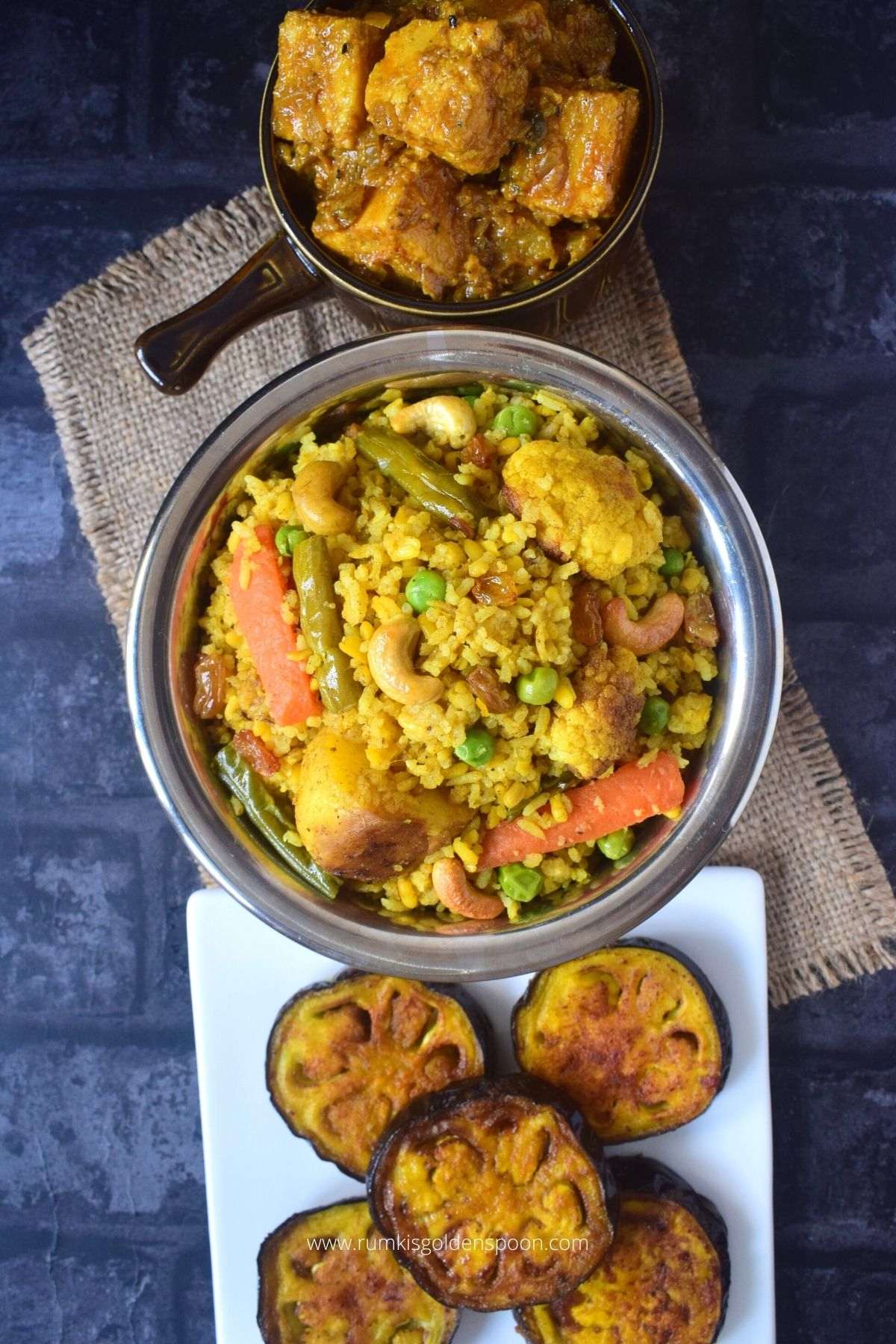
What is Gobindo bhog Chaal?
Gobindo Bhog Chaal (Rice) is very famous in West Bengal. In Bengal, this rice is specially used in preparing Kheer and Pulao. It is very tiny grained aromatic white Rice. It is mostly cultivated in few districts of West Bengal.
How to make bhuni khichuri?
To prepare the bhuni khichuri, first dry roast the sona moong dal (Split yellow lentils) for some time in medium flame and then soak it in water for half an hour. Drain the water and keep the sona moong dal aside. It will almost be double in size. This step helps the dal to get cooked quickly.
Then wash the gobindobhog rice (Small grain rice) and strain the water completely. Keep it aside for air drying.
Prepare the bata masala, I mean the homemade masala for the khichuri recipe. For the masala, add ginger, green chilli, cumin seeds and little water into the small jar of the grinder. Make a smooth paste with them. Then add turmeric powder, red chilli powder, coriander powder into the paste and give a nice blend. Keep the masala aside.
After this, cut the vegetables and wash them. Marinate the potatoes and cauliflower florets with salt and turmeric powder. Keep it aside.
Put a pan on flame and add mustard oil into it. Fry the cashew nuts till golden and raisins until they plump up and keep them aside on a separate plate.
Add the marinated potato chunk into the pan and fry them evenly over medium to medium high flame for 7-8 minutes till crisp and golden in colour. Then keep them aside on a separate plate.
In the same pan, add cauliflower florets and fry them over medium-to-medium-high flame for 10-12 minutes until it loses its crunch and brown spots occur on it. Then strain the cauliflower florets out and keep it aside.
Then add the carrots and beans and fry them for 4-5 minutes in medium flame and keep them aside.
In the same pan, add 2 tablespoons ghee and 2 tablespoons of mustard oil. Once it is hot enough, add whole spices – cumin seeds, dry red chillies, cinnamon stick, cloves, cardamoms, and bay leaves for tempering.
Add the masala paste into the pan and cook it until it releases oil. Add tomato chunks and cover the pan. Cook it in low flame until it gets soften.
Then add the gobindobhog rice into the pan and fry it on medium high flame for 2-3 minutes. Then add the soaked moong dal into the pan and mix it well. Fry both the rice and dal over medium flame for 7-8 minutes until the rice becomes opaque and a sound comes during the time of stirring. Stir the mixture continuously. This step takes some time to get the rice and dal fried properly but you need to be patient at this point.
Add hot water into the pan. Add salt, sugar and give a gentle stir. Cover the pan and cook it over medium flame for 5-6 minutes till the rice becomes visible.
Then add the fried vegetables into the pan and mix it. Put the flame in lowest and cover the pan. Put a towel over the lid so that the steam does not come out of the pan. Cook it for 15 minutes.
Then take off the lid of the pan and add green chillies, blanched peas, cashew nuts, raisins and Bengali garam masala, one by one into the pan and mix it nicely. Again, close the lid of the pan and reseal the pan with towel. Cook it for another 10 minutes in lowest flame. At this stage, you can also place the pan on a warm tawa and continue cooking, instead of cooking directly over the hob. Switch off the flame and don’t disturb the pan for further 10-15 more minutes.
Bengali garam masala is the combination of cinnamon, cardamom and cloves powder of equal proportions.
Then pour the bhuni khichdi into a large mixing bowl or else they may stick to each other in the hot pan.
Many bengali veg recipes have already been shared in my previous posts. You can check few of them like
Bhoger khichuri
Basanti pulao
Chanar dalna
Jhuri Aloo bhaja
Mishti Tomato Chutney
Chaaler payesh
..And Many more…
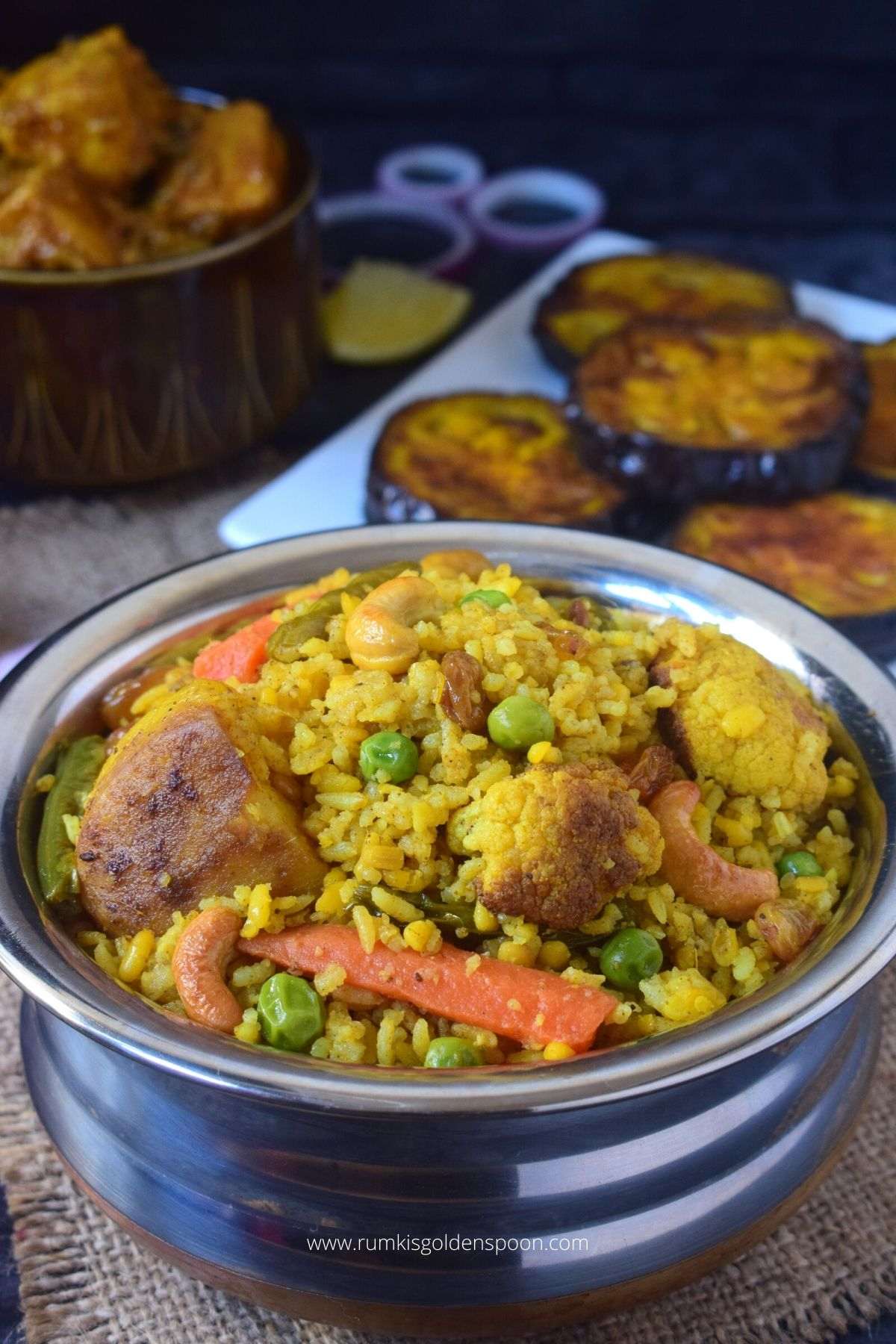
Ingredients:
1 cup = 250 ml
- 1 cup Gobindobhog Chal (Small grain rice)
- 1 cup Sona Moong Dal (Yellow Split lentils)
- 3 medium Potatoes, cut into 4 pieces
- 10 large Cauliflower florets
- 15 Beans
- 1 Carrot
- 1 Tomato, medium diced
- 1/3 cup green Peas, blanched
- 4 green Chillies
- 2 tablespoons Cashew nuts
- 2 tablespoons Raisins
- 1 teaspoon Bengali Garam Masala powder
- 2 teaspoons Salt (Adjust accordingly)
- 2 tablespoons Sugar (Adjust accordingly)
- 1 teaspoon Turmeric powder and salt, divided during the time of frying the potatoes and cauliflower
- 2 tablespoons Ghee (Clarified Butter)
- 6 tablespoons Mustard oil for cooking
- 4 cups hot Water
For tempering the bhuni khichuri
- 2 dry red Chillies
- 1 Bay leaf
- ½ teaspoon Cumin seeds
- 4 Cloves
- 2-inch Cinnamon stick
- 4-5 Cardamoms
For the Khichuri masala paste
- 2-inch Ginger, peeled and diced
- 1 green Chilli
- ¾ tablespoon Cumin seeds
- 3 tablespoons Water
- 1 teaspoon Turmeric powder
- 1 teaspoon Chilli powder
- 1 teaspoon Coriander powder
Instructions:
- First take a pan and let it become completely dry. Add the moong dal into the pan and dry roast it over medium flame for 3-4 minutes until the nutty aroma comes out from the dal.
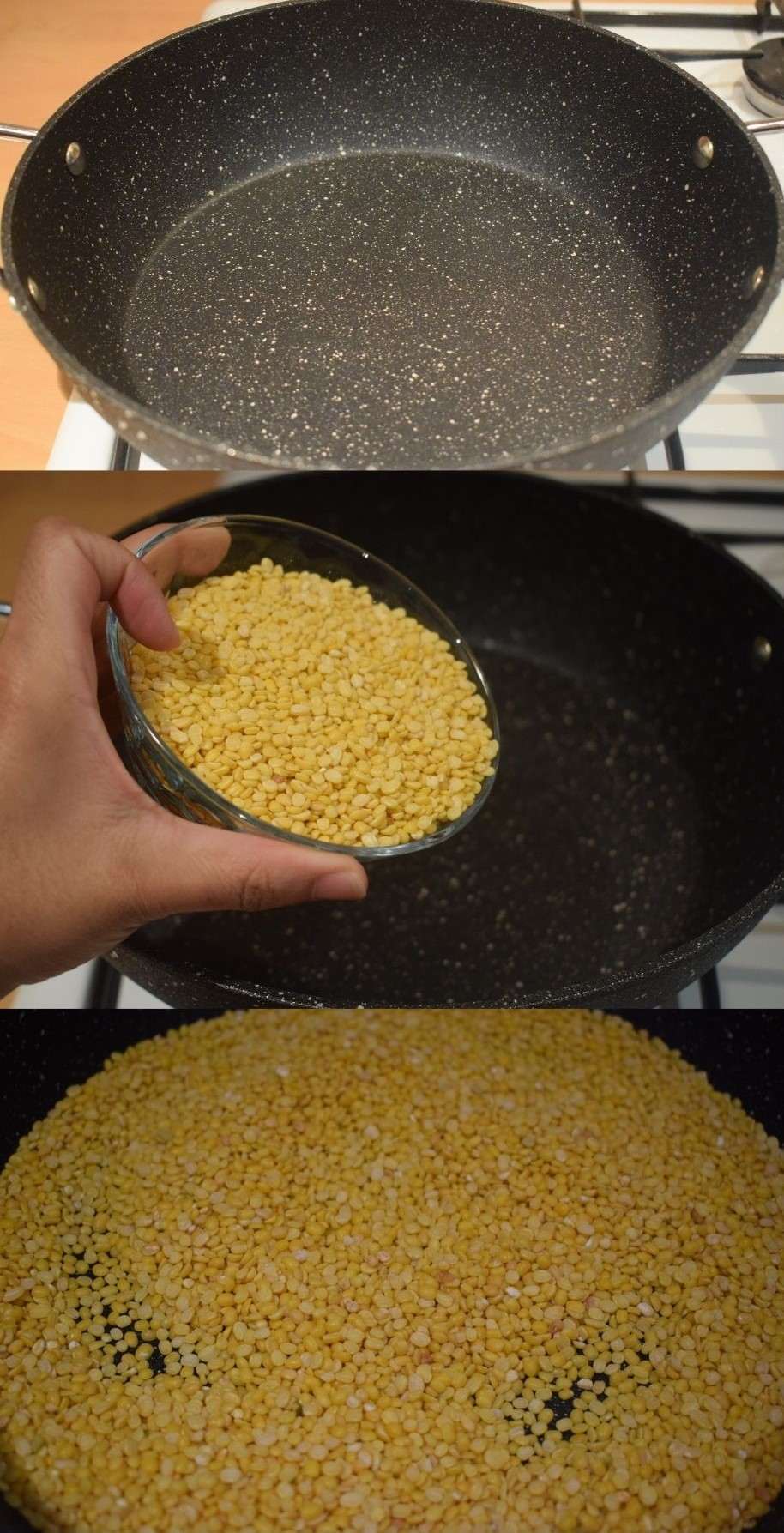
- Transfer the dal on a separate utensil and wash the dal once. Then soak the dal in hot water and cover it. Let the dal soak for at least half an hour and then drain the water. Keep the moong dal aside.

- Wash the Gobindobhog chaal 3-4 times until the water gets clear. Then strain the excess water with a strainer and keep it aside to get air dried.
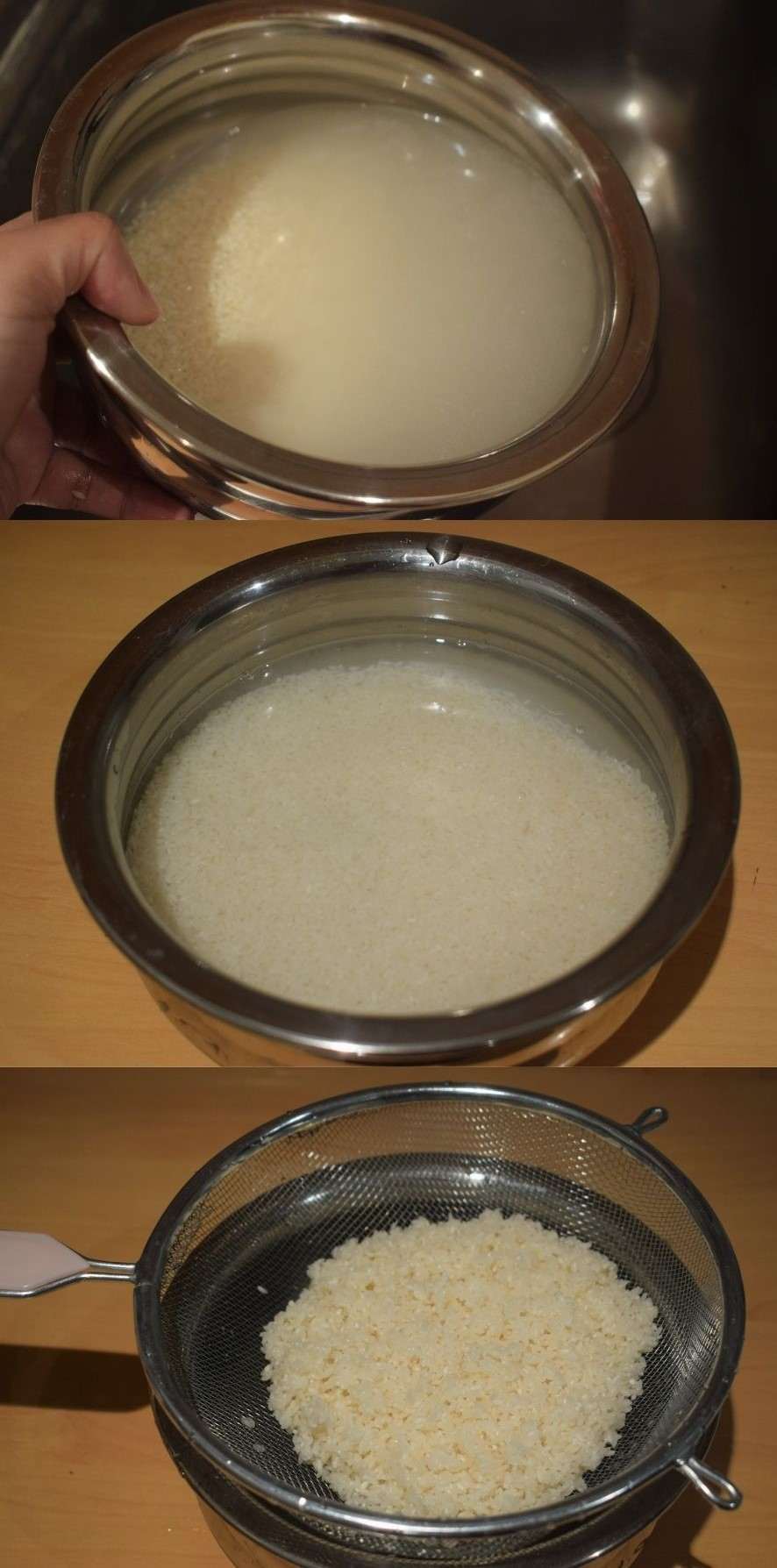
- Cut the cauliflower florets into even medium size pieces and wash them. Add ½ teaspoon salt, ½ teaspoon turmeric powder and mix it evenly so each cauliflower florets can get coated. Keep it aside.

- Cut each medium sized potato into flour pieces. Add ½ teaspoon salt, ½ teaspoon turmeric powder and mix it nicely to coat each potato piece. Keep it aside.
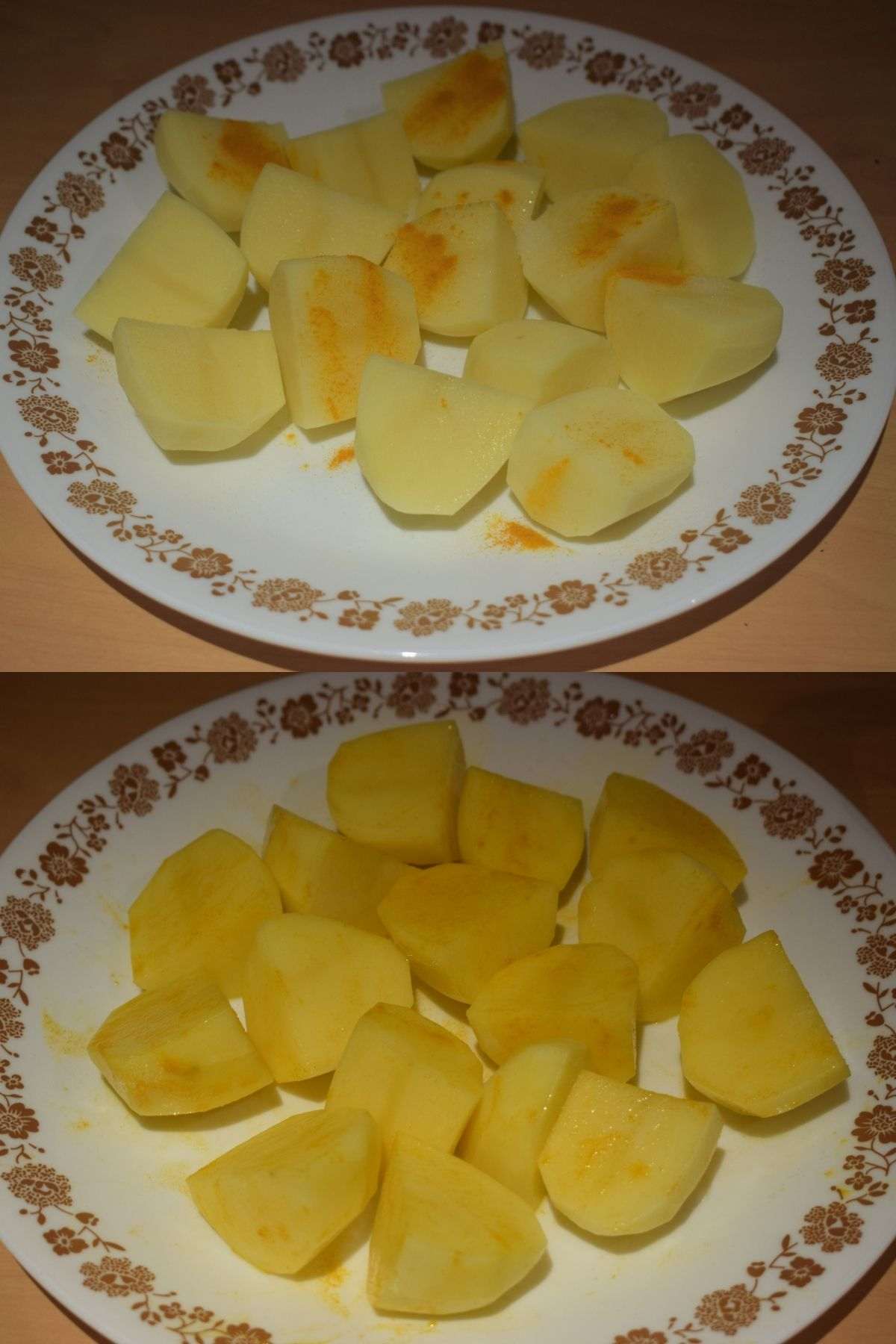
- For the masala, add the ginger pieces and 1 green chilli into the small jar of the grinder. Then add ¾ tablespoon cumin seeds into the jar. Add a little bit of water around 3 tablespoons and pulse the spices to a smooth paste.
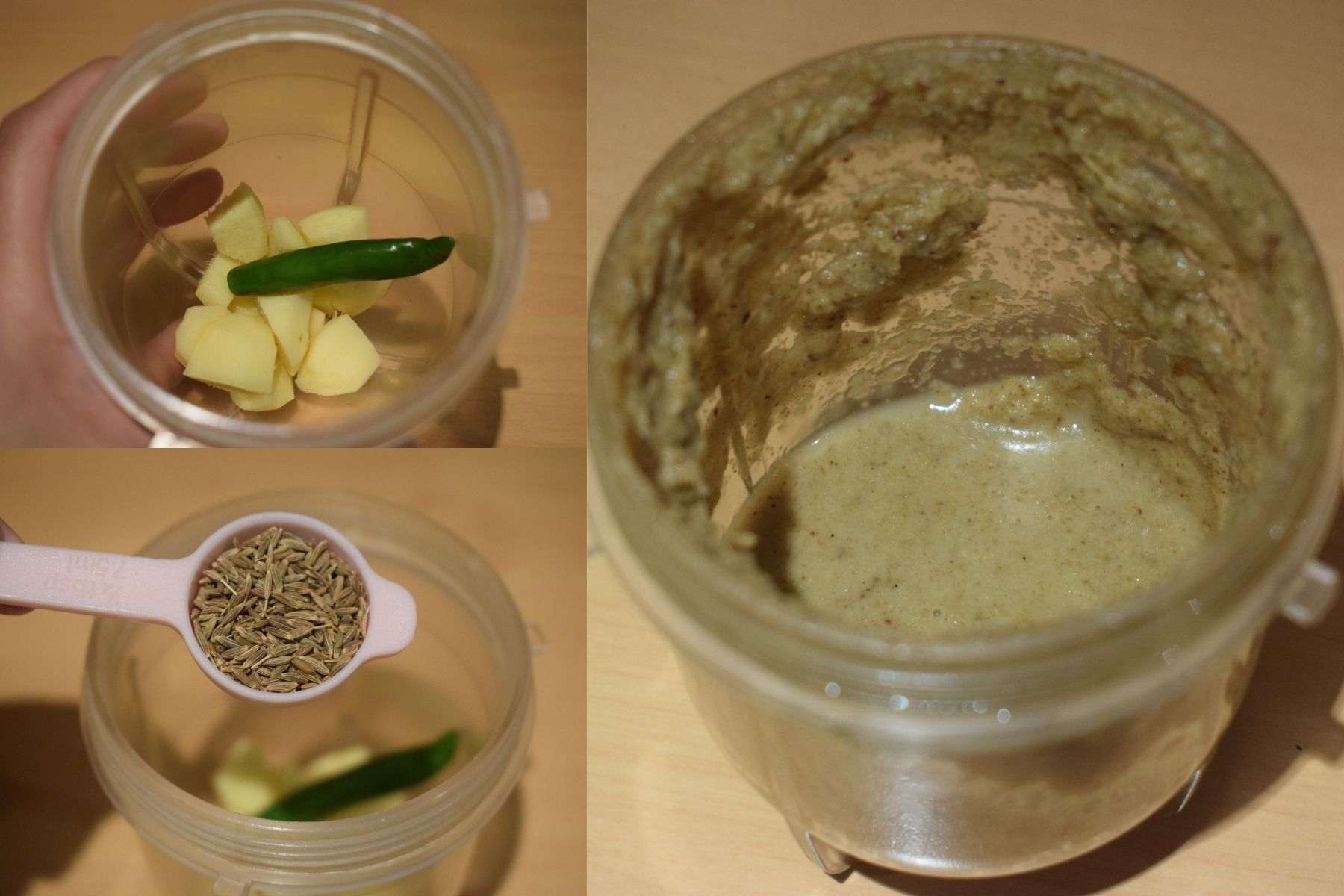
- Add 1 teaspoon turmeric powder, 1 teaspoon chilli powder, 1 teaspoon coriander powder into the jar and blend it once more. Keep the masala aside.

- Take a pan and add ¼ cup mustard oil into it. Put the flame in high and wait until the oil is hot.
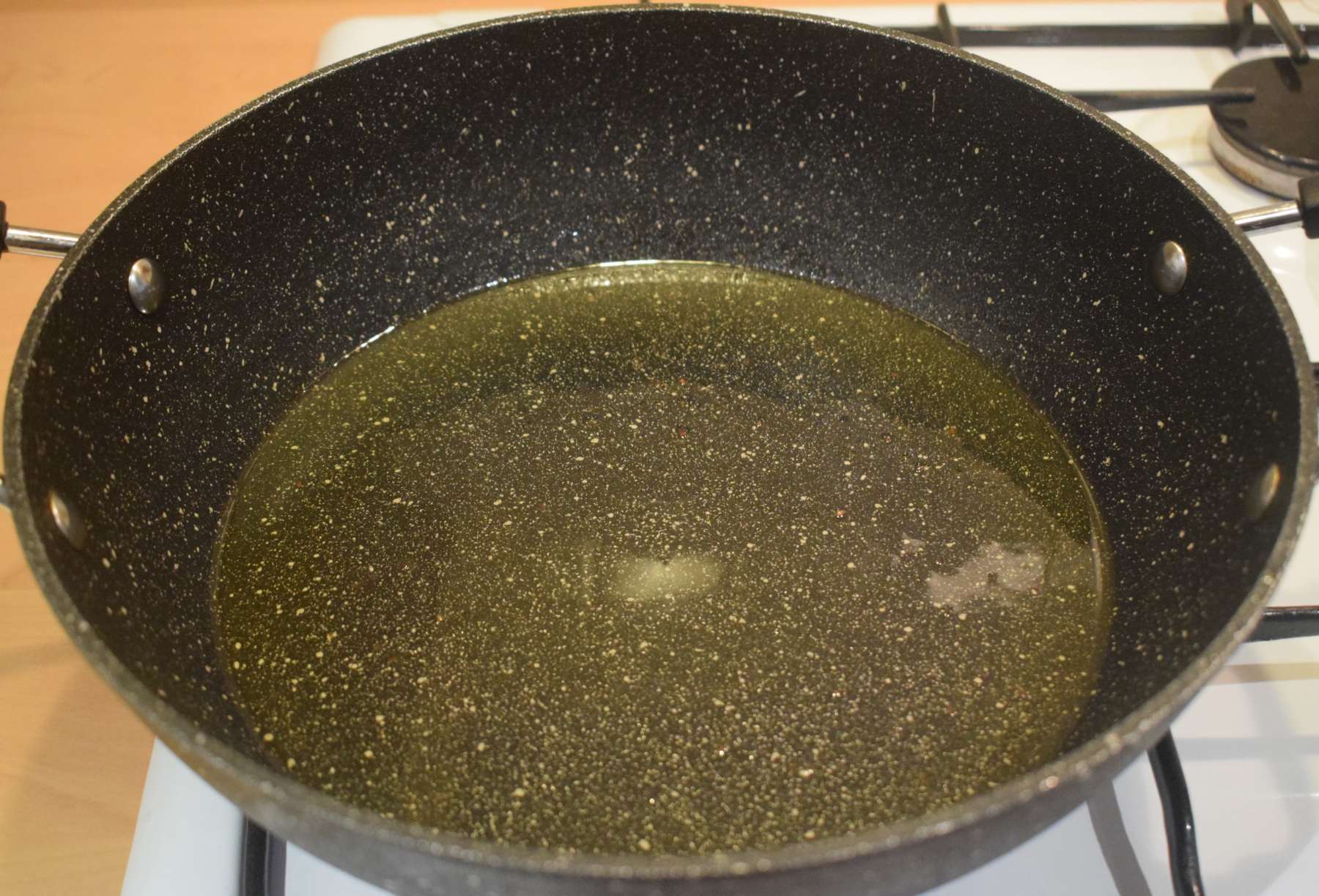
- Once the oil is hot, add the marinated potato chunk into the pan and then fry them evenly over medium to medium high flame for 7-8 minutes till crisp and golden in colour. Then keep them aside on a separate plate.
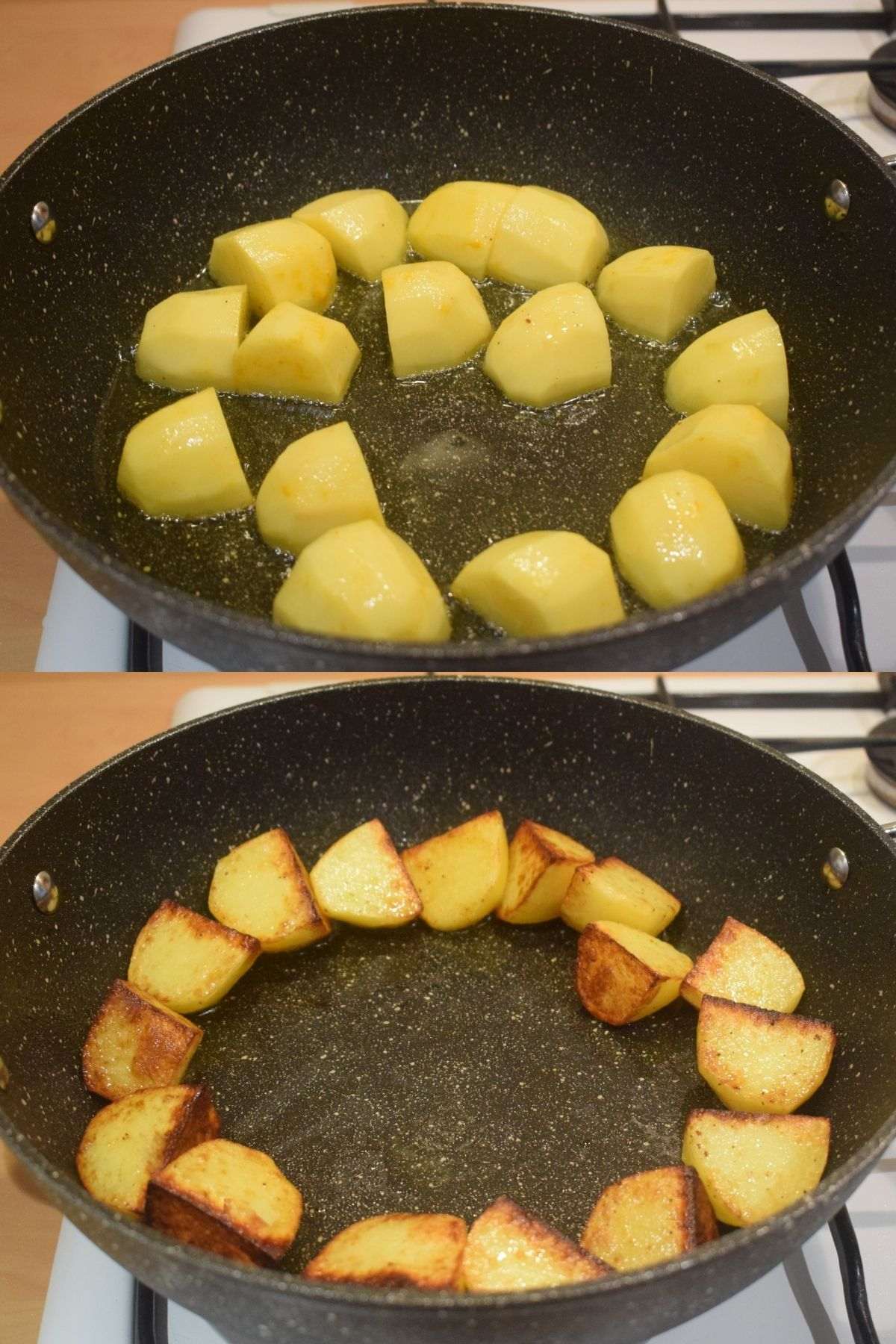
- In the same pan, add cauliflower florets and fry them over medium-to-medium high flame for 10-12 minutes until it loses its crunch and brown spots occur on it. Then strain the cauliflower florets out and keep it aside.

- Add some oil if required and then add the carrots and beans and fry them for 4-5 minutes in medium flame and keep them aside.

- Add cashew nuts into it and fry them till golden. Keep the cashews on a separate plate.
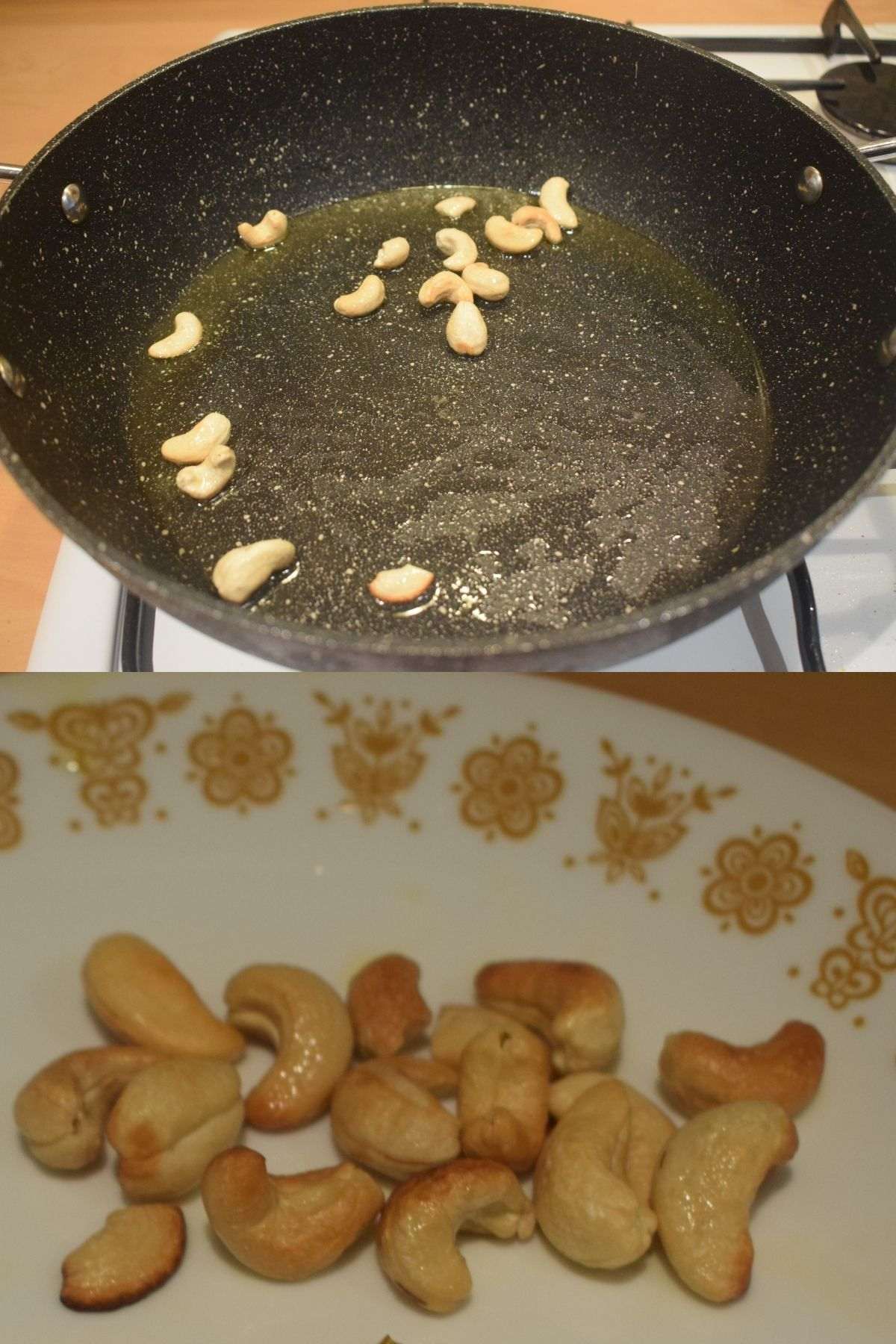
- Add raisins into the pan and fry them till they plump up. Keep them aside on a separate plate.

- Into the same pan, add 2 tablespoons ghee, 2 tablespoons of mustard oil and allow it to become hot.
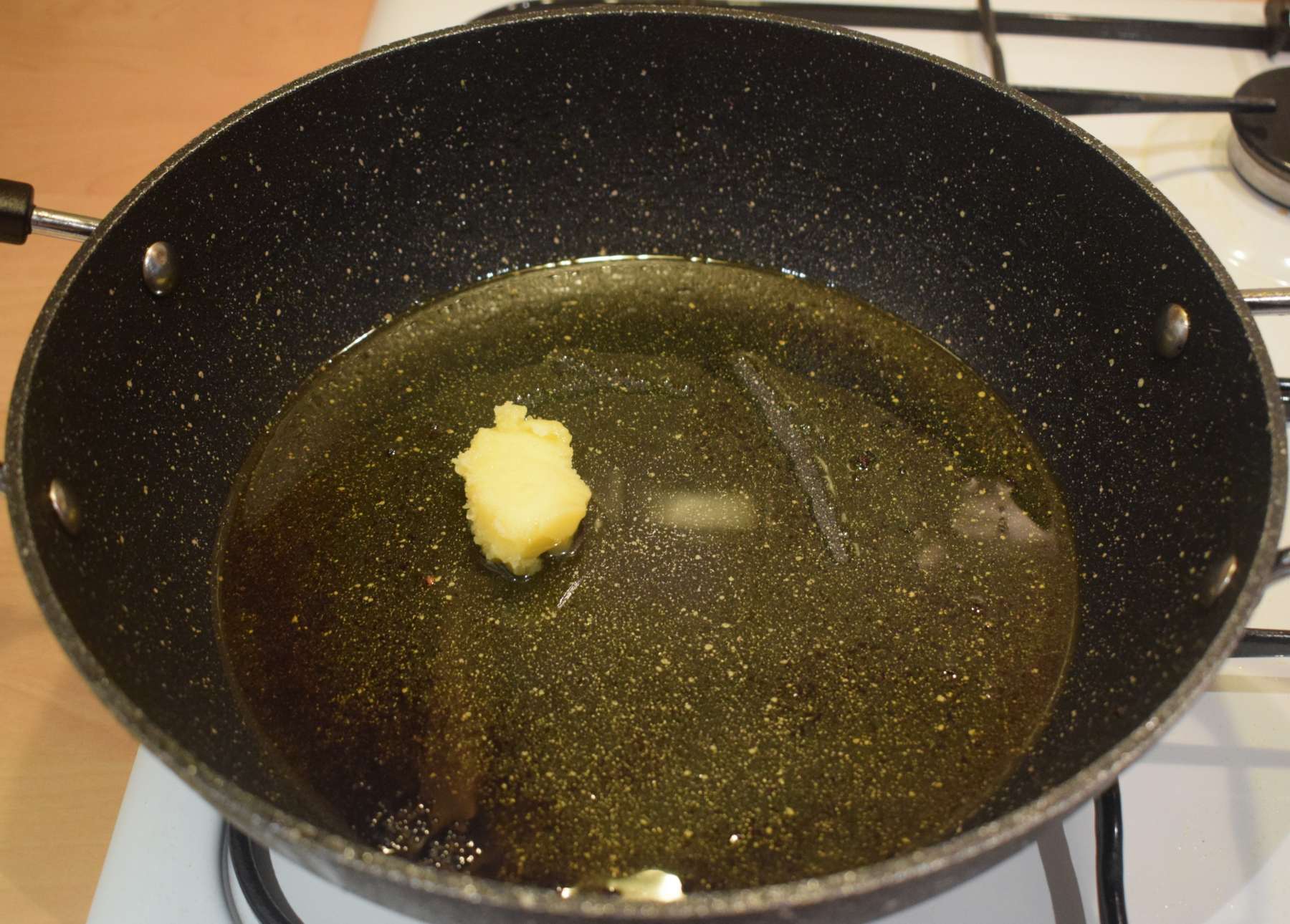
- Once it is hot enough, add whole spices – ½ teaspoon cumin seeds, 2 dry red chillies, 2 inches cinnamon stick, 4 cloves, 4 cardamoms, 1 bay leaf for tempering and let them crackle.
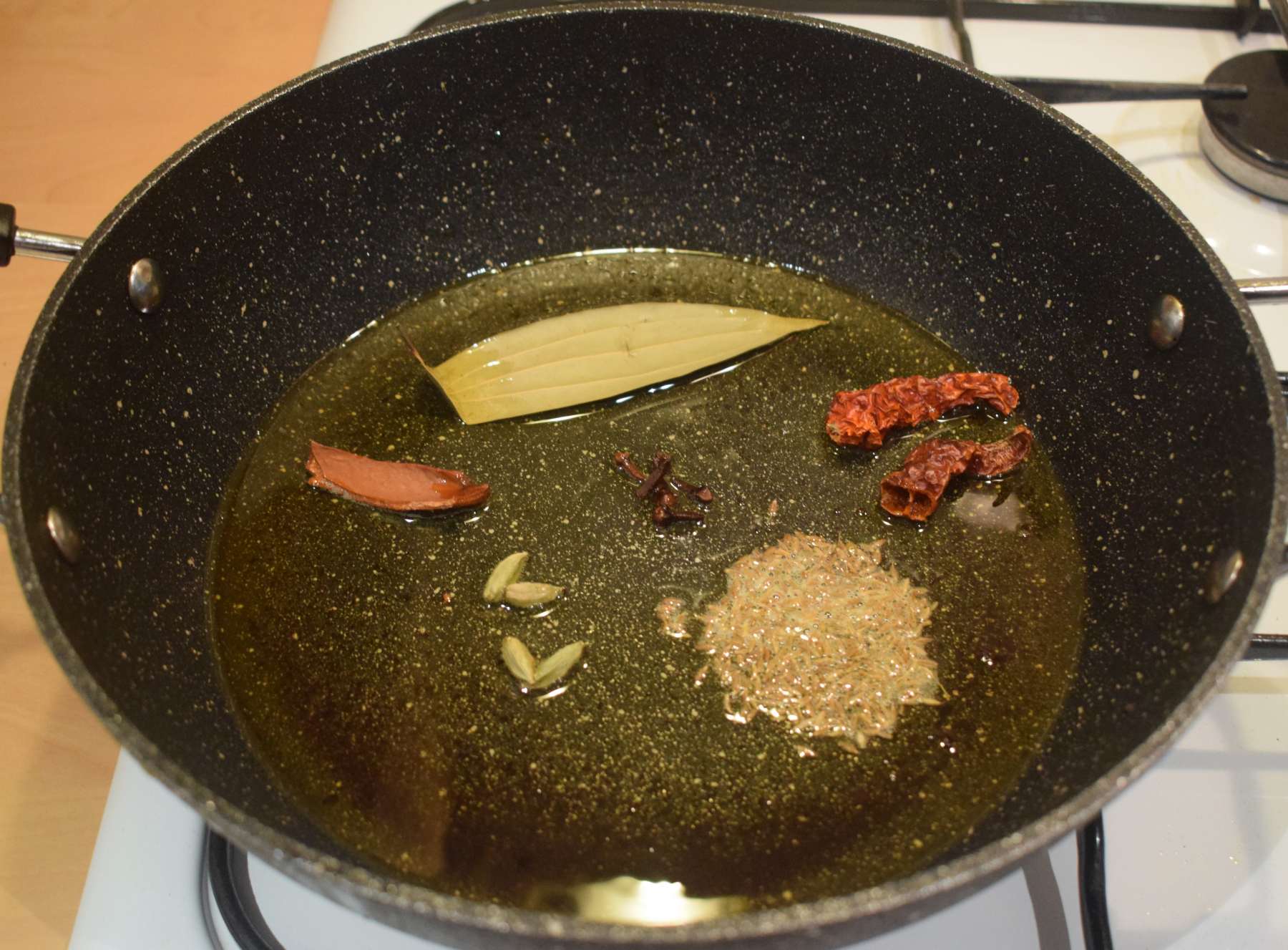
- Add the masala paste (Step 7) into the pan and give a nice stir. Cook it in medium flame for 2-3 minutes until it releases oil.
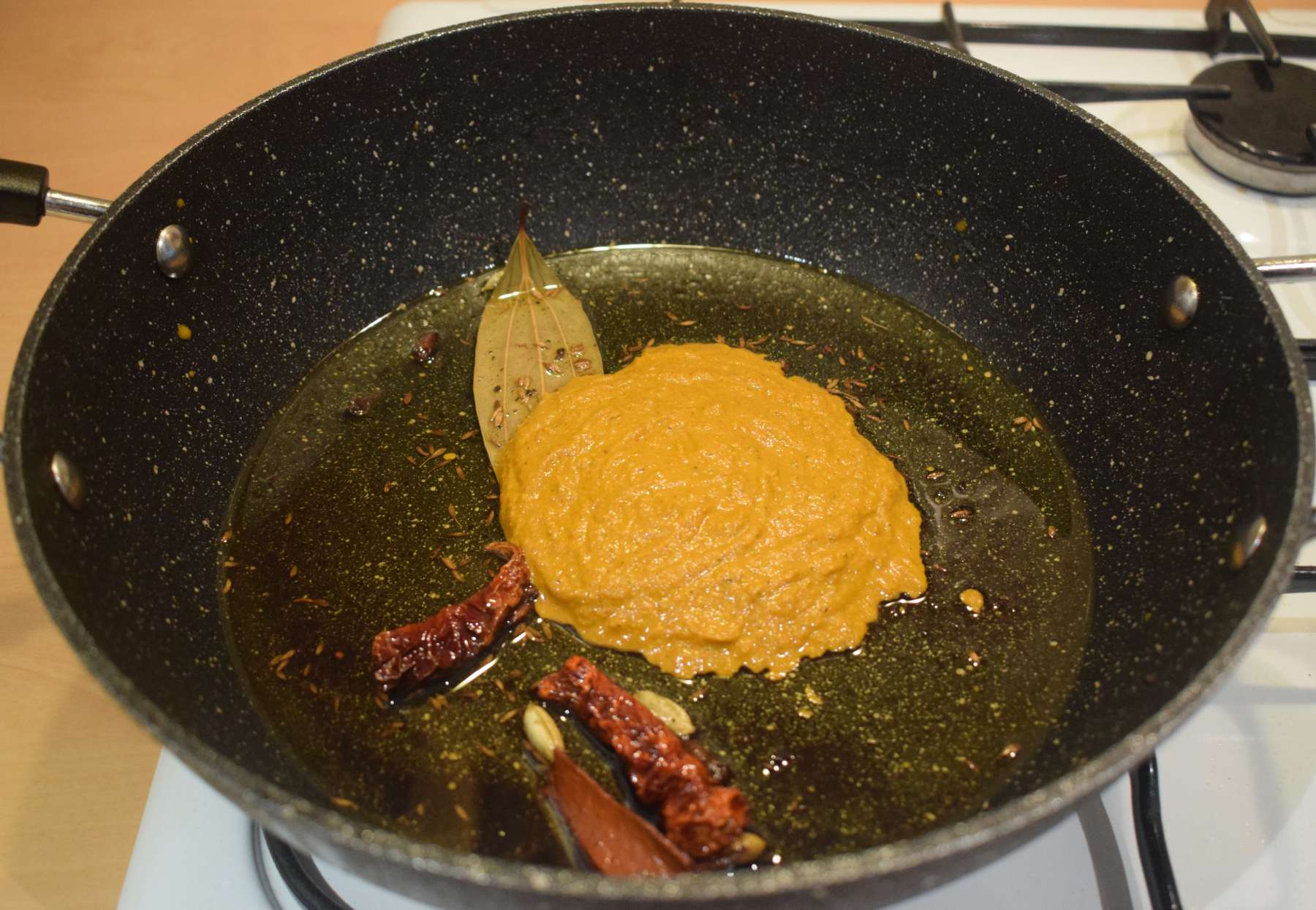
- Add tomato chunks into the pan and give a nice mix. Cover the pan and cook it in low flame for another 4-5 minutes until the tomatoes get soft.

- Add the gobindobhog rice (Step 3) into the pan and give a nice mix. Cook it over medium flame for 2-3 minutes.
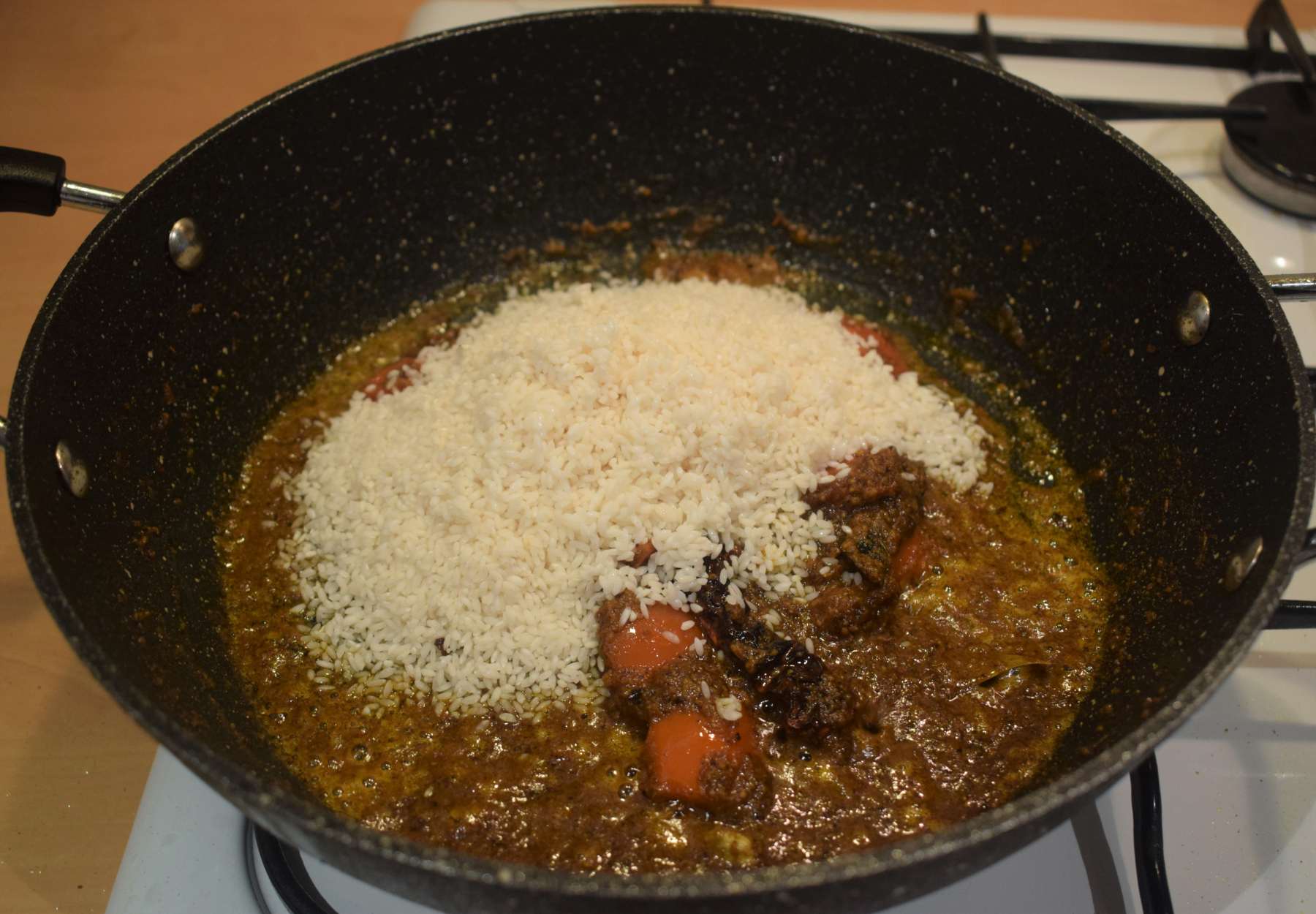
- Add the soaked moong dal (Step 2) into the pan and give a nice mix. Fry both the rice and dal over medium flame for 7-8 minutes until the rice becomes opaque and a sound comes during the time of stirring. Stir the mixture continuously. This step takes some time to fry the dal-rice properly, but you need to be patient at this point.
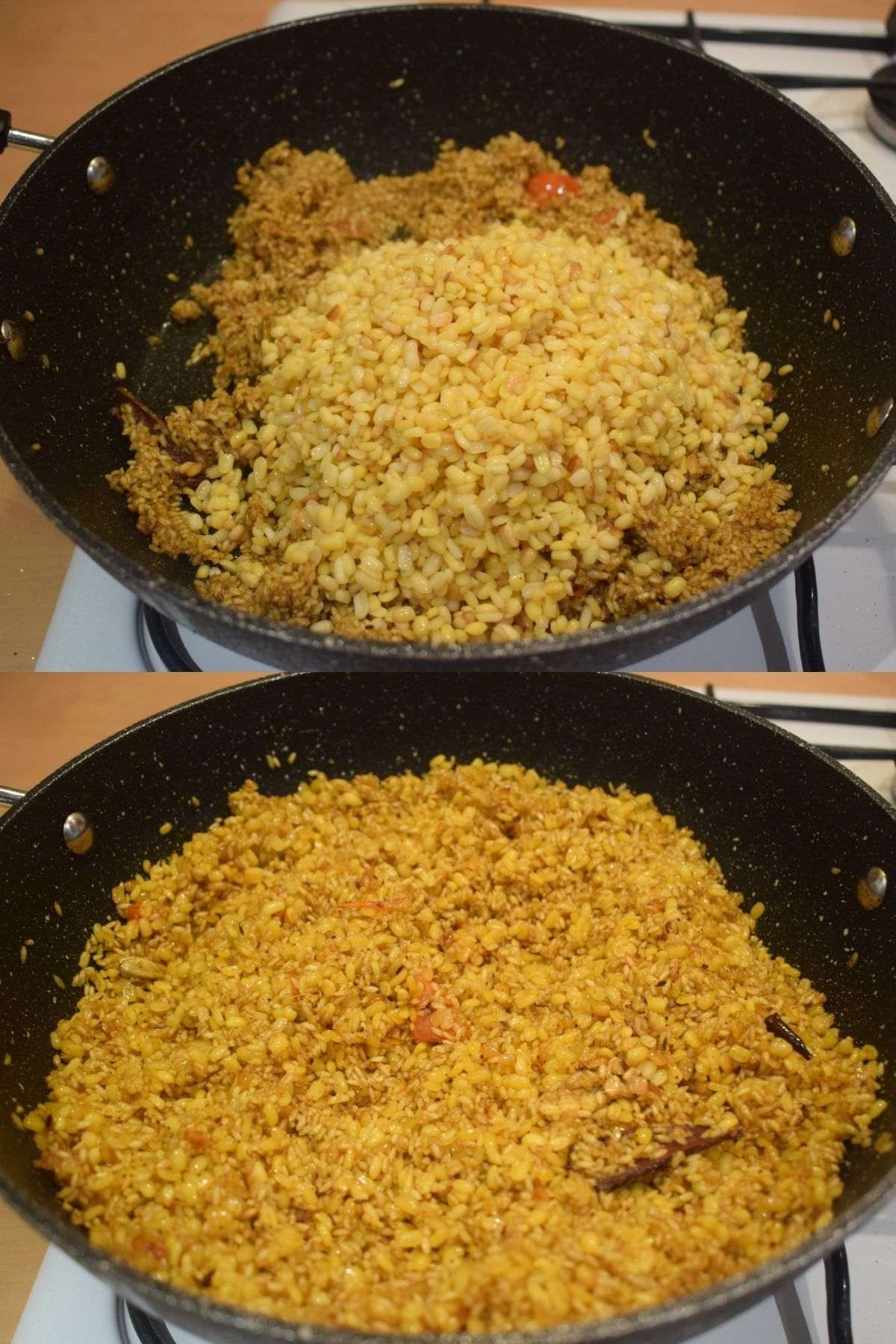
- Add 4 cups hot water into the pan. Add 2 teaspoons salt, 2 tablespoons sugar and give a gentle stir. Cover the pan and cook it over medium flame for 5-6 minutes till the rice becomes visible.
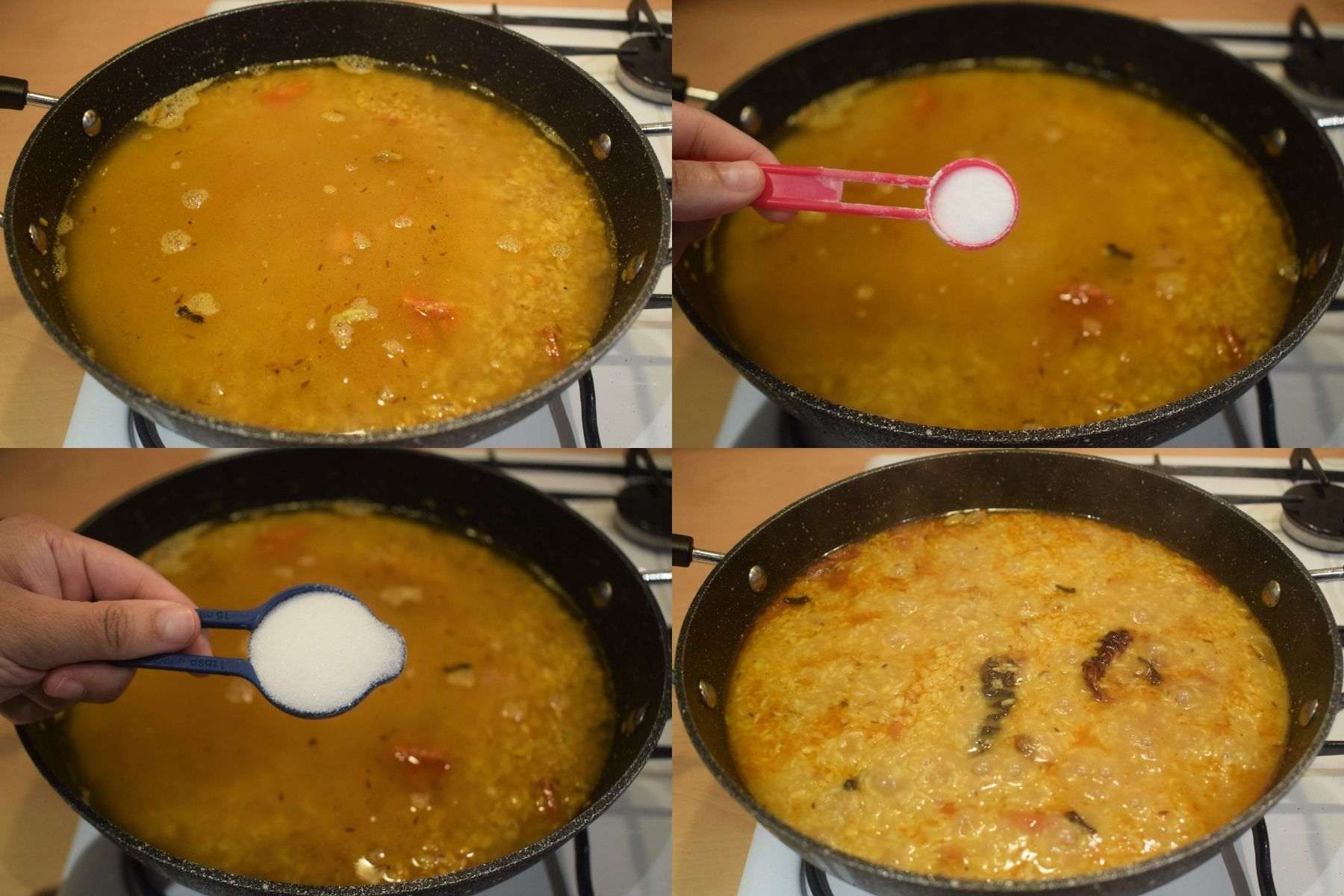
- Add the fried vegetables into the pan and mix it.
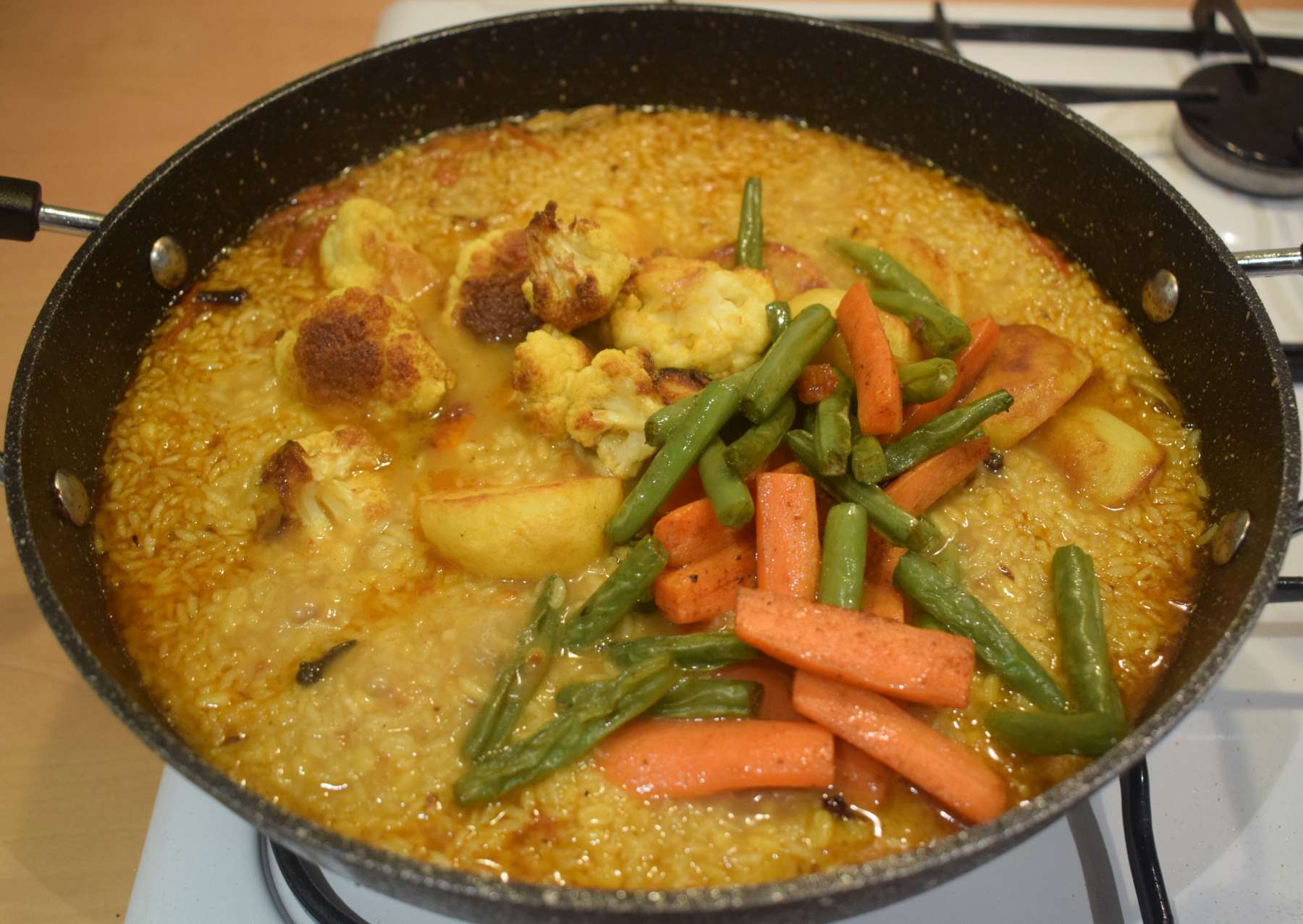
- Put the flame in lowest and cover the pan. Put a towel over the lid so that the steam does not come out of the pan. Cook it for 15 minutes.
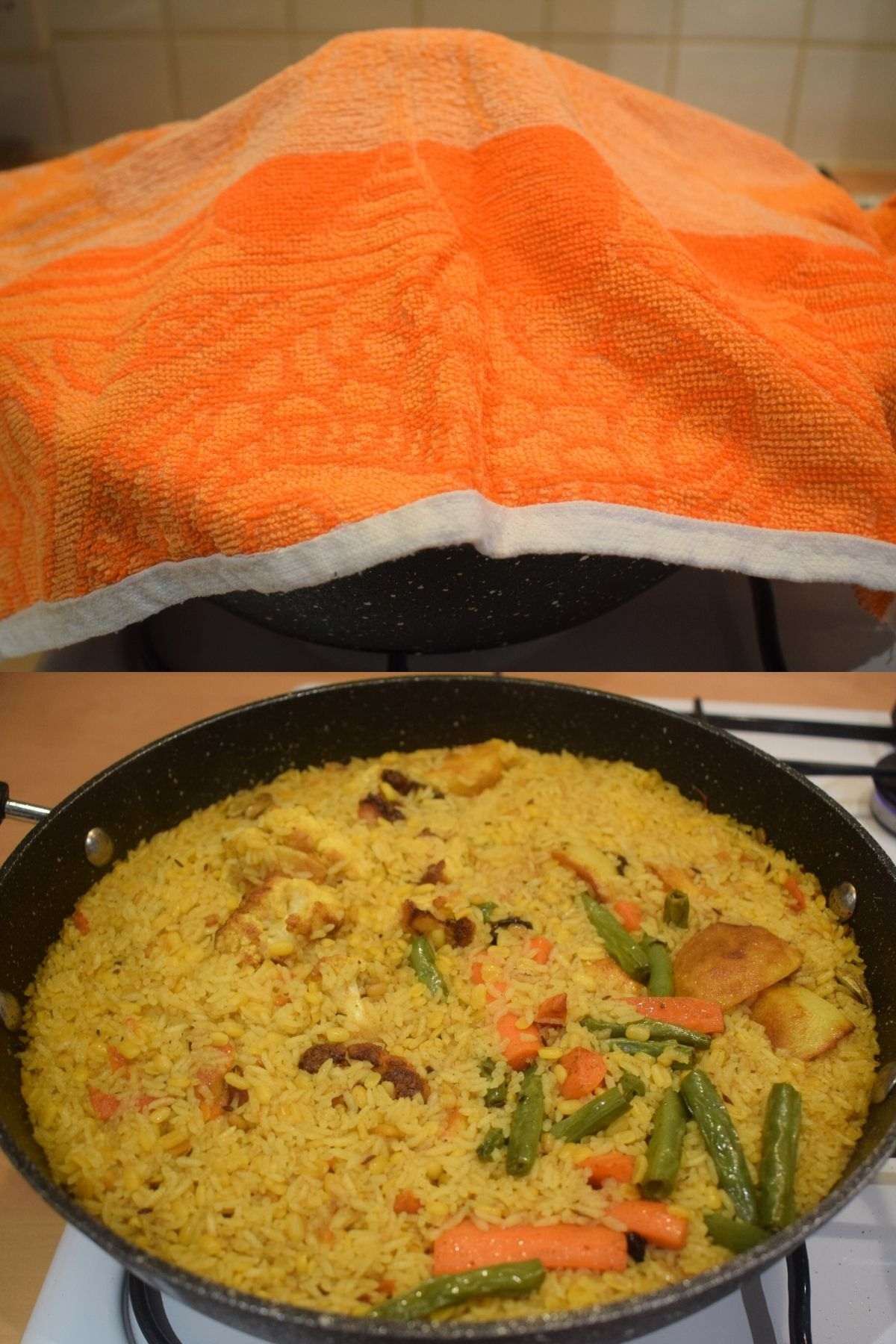
- Take off the lid of the pan and add 4 green chillies, 1/3 cup blanched peas, fried cashew nuts and raisins, 1 teaspoon Bengali garam masala, one by one into the pan and mix it nicely.
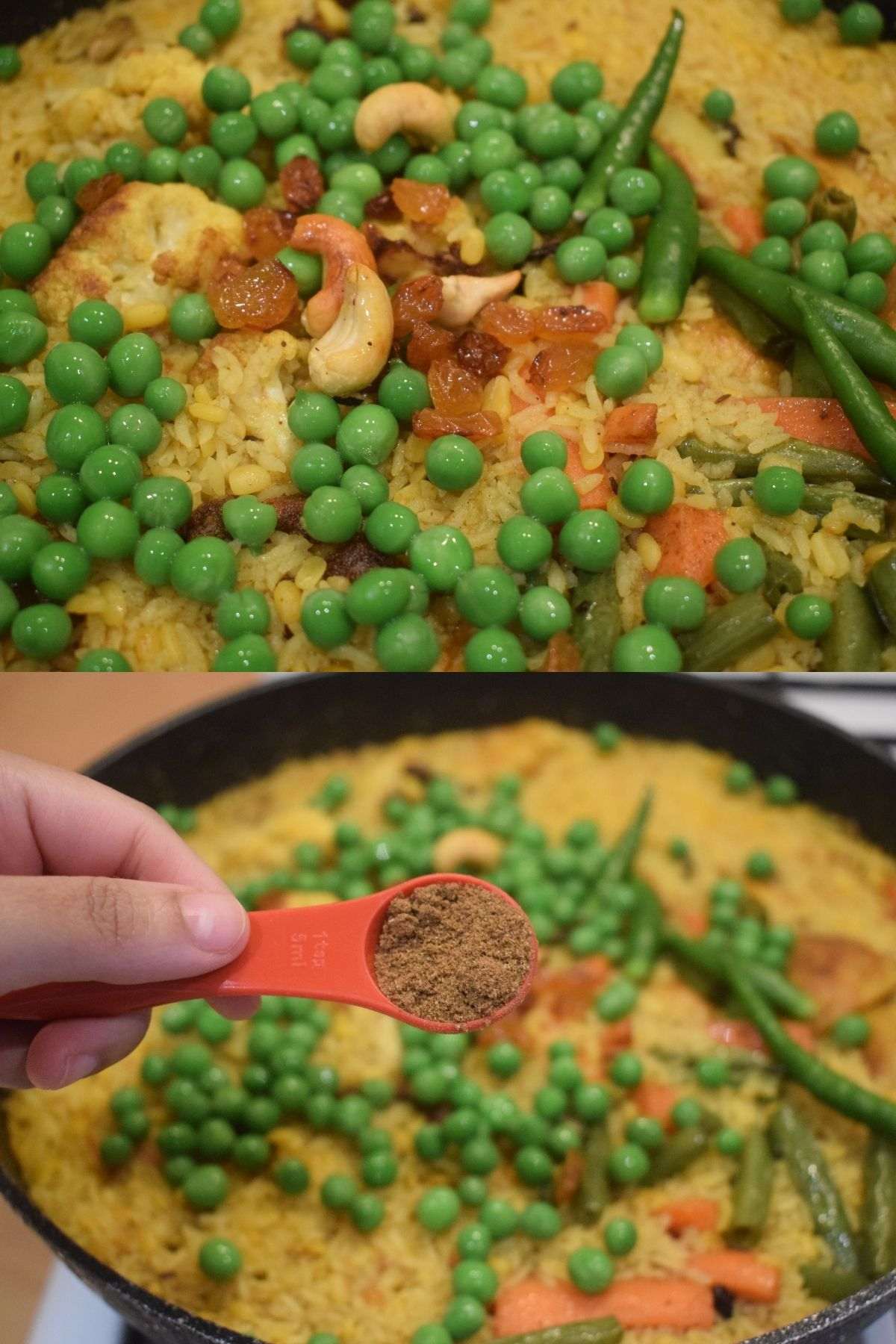
- Again, close the lid of the pan and reseal the pan with towel. Cook it for another 10 minutes in lowest flame. At this stage, you can also place the pan on a warm tawa and cook, instead of cooking directly over the hob. For the perfect textured bhuna khichuri, timing is very important.
- Switch off the flame and don’t disturb the pan for further 10-15 more minutes.
- Take off the towel and lid of the pan after 15 minutes interval and give a gentle mix. Pour the bhuni khichuri into a separate large mixing bowl for fluffy texture, or else it may stick to each other sitting into the hot pan.
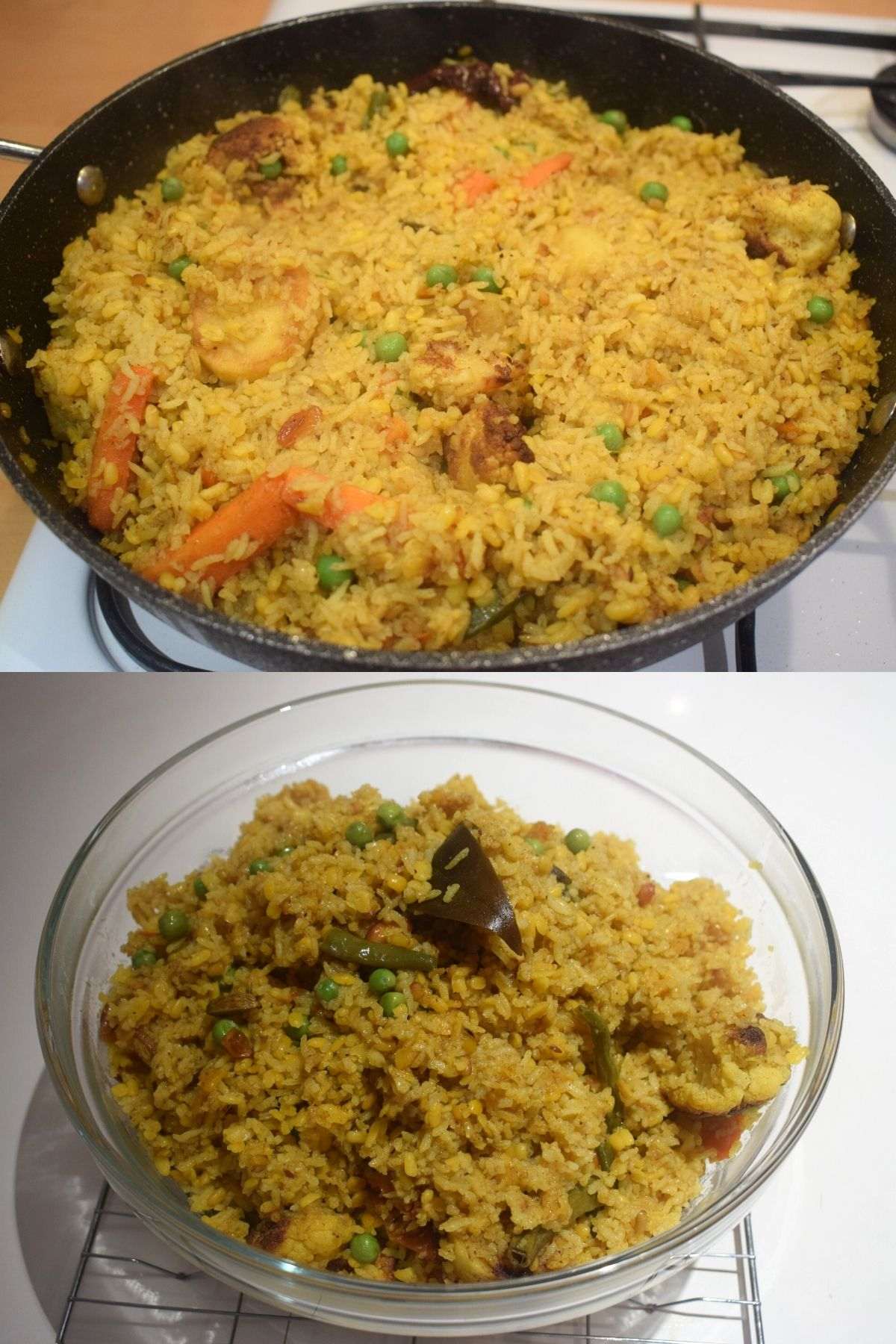
Serving Instruction
Serve the portions of Bhuni khichuri on serving plates. Serve hot or warm for the best taste. Pair up the authentic dish with bhoger labra, niramish alur dom or paneer curry and enjoy the eternal taste of Bengali food.
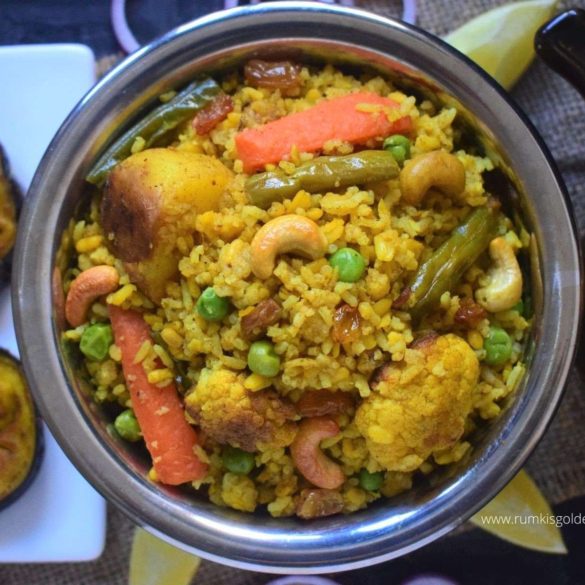
Ingredients
1 cup = 250 ml
- 1 cup Gobindobhog Chal (Small grain rice)
- 1 cup Sona Moong Dal (Yellow Split lentils)
- 3 medium Potatoes, cut into 4 pieces
- 10 large Cauliflower florets
- 15 Beans
- 1 Carrot
- 1 Tomato, medium diced
- 1/3 cup green Peas, blanched
- 4 green Chillies
- 2 tablespoons Cashew nuts
- 2 tablespoons Raisins
- 1 teaspoon Bengali Garam Masala powder
- 2 teaspoons Salt (Adjust accordingly)
- 2 tablespoons Sugar (Adjust accordingly)
- 1 teaspoon Turmeric powder and salt, divided during the time of frying the potatoes and cauliflower
- 2 tablespoons Ghee (Clarified Butter)
- 6 tablespoons Mustard oil for cooking
- 4 cups hot Water
For tempering the bhuni khichuri
- 2 dry red Chillies
- 1 Bay leaf
- ½ teaspoon Cumin seeds
- 4 Cloves
- 2-inch Cinnamon stick
- 4-5 Cardamoms
For the Khichuri masala paste
- 2-inch Ginger, peeled and diced
- 1 green Chilli
- ¾ tablespoon Cumin seeds
- 3 tablespoons Water
- 1 teaspoon Turmeric powder
- 1 teaspoon Chilli powder
- 1 teaspoon Coriander powder
Instructions
- First take a pan and let it become completely dry. Add the moong dal into the pan and dry roast it over medium flame for 3-4 minutes until the nutty aroma comes out from the dal.
- Transfer the dal on a separate utensil and wash the dal once. Then soak the dal in hot water and cover it. Let the dal soak for at least half an hour and then drain the water. Keep the moong dal aside.
- Wash the Gobindobhog chaal 3-4 times until the water gets clear. Then strain the excess water with a strainer and keep it aside to get air dried.
- Cut the cauliflower florets into even medium size pieces and wash them. Add ½ teaspoon salt, ½ teaspoon turmeric powder and mix it evenly so each cauliflower florets can get coated. Keep it aside.
- Cut each medium sized potato into flour pieces. Add ½ teaspoon salt, ½ teaspoon turmeric powder and mix it nicely to coat each potato piece. Keep it aside.
- For the masala, add the ginger pieces and 1 green chilli into the small jar of the grinder. Then add ¾ tablespoon cumin seeds into the jar. Add a little bit of water around 3 tablespoons and pulse the spices to a smooth paste.
- Add 1 teaspoon turmeric powder, 1 teaspoon chilli powder, 1 teaspoon coriander powder into the jar and blend it once more. Keep the masala aside.
- Take a pan and add ¼ cup mustard oil into it. Put the flame in high and wait until the oil is hot.
- Once the oil is hot, add the marinated potato chunk into the pan and then fry them evenly over medium to medium high flame for 7-8 minutes till crisp and golden in colour. Then keep them aside on a separate plate.
- In the same pan, add cauliflower florets and fry them over medium-to-medium high flame for 10-12 minutes until it loses its crunch and brown spots occur on it. Then strain the cauliflower florets out and keep it aside.
- Add some oil if required and then add the carrots and beans and fry them for 4-5 minutes in medium flame and keep them aside.
- Add cashew nuts into it and fry them till golden. Keep the cashews on a separate plate.
- Add raisins into the pan and fry them till they plump up. Keep them aside on a separate plate.
- Into the same pan, add 2 tablespoons ghee, 2 tablespoons of mustard oil and allow it to become hot.
- Once it is hot enough, add whole spices – ½ teaspoon cumin seeds, 2 dry red chillies, 2 inches cinnamon stick, 4 cloves, 4 cardamoms, 1 bay leaf for tempering and let them crackle.
- Add the masala paste (Step 7) into the pan and give a nice stir. Cook it in medium flame for 2-3 minutes until it releases oil.
- Add tomato chunks into the pan and give a nice mix. Cover the pan and cook it in low flame for another 4-5 minutes until the tomatoes get soft.
- Add the gobindobhog rice (Step 3) into the pan and give a nice mix. Cook it over medium flame for 2-3 minutes.
- Add the soaked moong dal (Step 2) into the pan and give a nice mix. Fry both the rice and dal over medium flame for 7-8 minutes until the rice becomes opaque and a sound comes during the time of stirring. Stir the mixture continuously. This step takes some time to fry the dal-rice properly, but you need to be patient at this point.
- Add 4 cups hot water into the pan. Add 2 teaspoons salt, 2 tablespoons sugar and give a gentle stir. Cover the pan and cook it over medium flame for 5-6 minutes till the rice becomes visible.
- Add the fried vegetables into the pan and mix it.
- Put the flame in lowest and cover the pan. Put a towel over the lid so that the steam does not come out of the pan. Cook it for 15 minutes.
- Take off the lid of the pan and add 4 green chillies, 1/3 cup blanched peas, fried cashew nuts and raisins, 1 teaspoon Bengali garam masala, one by one into the pan and mix it nicely.
- Again, close the lid of the pan and reseal the pan with towel. Cook it for another 10 minutes in lowest flame. At this stage, you can also place the pan on a warm tawa and cook, instead of cooking directly over the hob. For the perfect textured bhuna khichuri, timing is very important.
- Switch off the flame and don’t disturb the pan for further 10-15 more minutes.
- Take off the towel and lid of the pan after 15 minutes interval and give a gentle mix. Pour the bhuni khichuri into a separate large mixing bowl for fluffy texture, or else it may stick to each other sitting into the hot pan.

